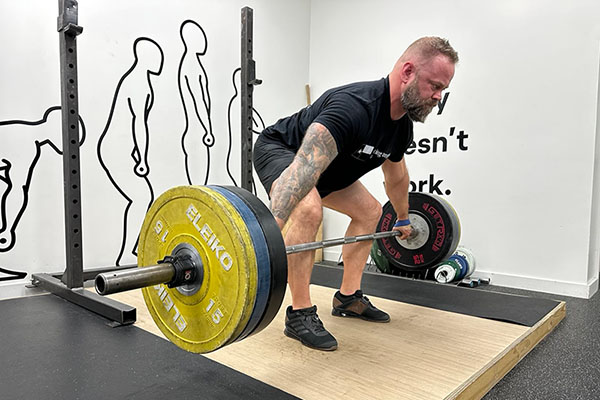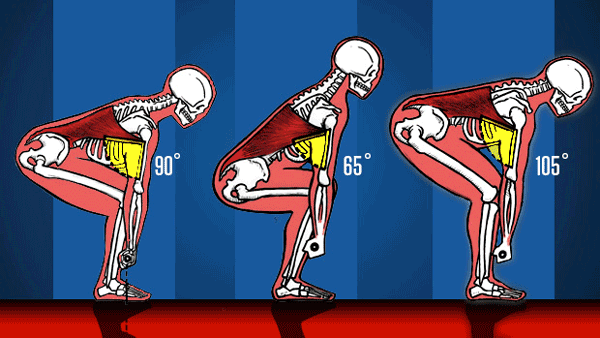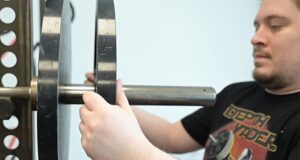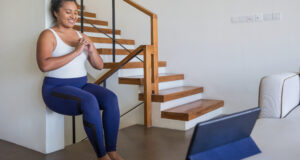Most of us should be deadlifting. And by most of us, I mean all of us. We should follow the novice progression, deadlifting every day. Then alternate in power cleans, then chin-ups. After that probably some sort of heavy-light-medium variation. Or, if you have access to your youth, whole milk, and XY chromosomes, the Texas Method. If you have moved beyond weekly progressions, then you have probably been exposed to the rack pull, maybe paused deadlifts, and if you have offended your coach, haltings. At some point in your intermediate to advanced programming it might behoove you to introduce other deadlift variations.
These children of the parent movement can serve multiple purposes. If there are egregious technique errors, then it is almost always better to reduce weight and get the conventional deadlift correct. However, there are times when assistance movements might be helpful. A paused deadlift, for example, may teach a lifter to extend his knees before the hips, maintain shoulder extension, and keep his back set in rigid extension in the first part of the pull.
A paused deadlift could spread out the stress-recovery-adaptation cycle – it is artificially felt to be heavy (because of the pause) even though it is necessarily lighter (because of the pause). In this way, an athlete can deadlift, but not at a load that will produce as much systemic stress as a conventional deadlift. And sometimes, when things line up, an introduction of the variation could serve both purposes of addressing technique while also spreading out stress – it takes some skill and experience on the part of the coach for it to work out this way.
Here, I would like to examine the snatch-grip and the deficit versions of the deadlift. They both must be lighter because of the increased range of motion, but in quite different ways.
The Snatch-Grip Deadlift
The hallmark of the snatch-grip deadlift is just that– the snatch-grip, called thus for the wide grip taken on the bar that resembles the Olympic snatch. The wide grip, the abduction of the arms as seen from the frontal plane, means that there is contractile force from the lats both keeping the bar over mid-foot and keeping the arms from adducting to plumb. This means that the athlete will have to pull the bar much harder into their legs, which might be a beneficial variation for teaching athletes to use their lats during the pull.

Josh Wells trains the snatch-grip deadlift at Starting Strength Katy. (Credit: Shelley Wells)
This also means that
the hips will be much higher in the setup, closing the hips angle and
opening the knee angle – like a snatch start position. Even with
this anatomical manipulation, the hamstrings remain in isometric
contraction at the start of the pull since the knees are opened to
the extent the hips closed, as in the conventional deadlift.

Angle of the lats with the hips at correct (left) and incorrect heights (center, right). (Adapted from Starting Strength: Basic Barbell Training, 3rd ed)
The image on the far right might be the hip height or the start
position of the snatch-grip deadlift (more closed), but because of
the wider grip, the knees will need to be bent further, as in the
middle image. A correct set-up puts the hamstrings in isometric
contraction at the start as well as the lats angled to insertion at
90 degrees from their origin, the strongest angle for them to pull to
keep the bar over mid-foot. Just like the hamstrings reaching further
than ideal extensibility in the far right image, and less so in the
middle image, the lats too will be brought into isometric contraction
with the higher hips and more bent knees.
The grip width need not
be your actual snatch grip width in an attempt to mimic your snatch
(your hip height will approximate itself based on grip width for the
lats and hamstrings to “lock-in” isometrically). Further, to
attempt to mimic your actual snatch would violate the analysis and
evidence that suggests training should not mimic sports practice.
That analysis, germane to this topic, is discussed in The Two-Factor Model of Sports Performance. In other words, we are doing the snatch-grip deadlift to get stronger,
not to practice a snatch.
Approach the bar and do
your 5-step-setup for the deadlift. In step 2, take a grip on the bar
that is wider than your conventional deadlift grip width. It needs to
be wide, but not necessarily your snatch grip width. If it is, fine.
Whatever it is, it needs to be consistent. Then finish the last 3
deadlift setup steps. Do this and you will have done a successful
snatch-grip deadlift. But it is going to be vastly different from
your conventional deadlift in important ways.
Rewind to step 1: the
stance. The bottom position of the snatch and snatch-grip
deadlift manipulates your anatomical angles in uncomfortable ways.
You are going to have to have your back angle more horizontal and hip
angle more closed, and therefore more of your torso between your
legs. To facilitate this you might have to do one or a combination of
the following: turn your toes out more so you can point your knees
out, angling your femurs out more, thereby making more room between
the thighs. Or you can take a wider stance with feet at the same
angle as your conventional deadlift– also putting more room between
your thighs. With toes out more the adductors will be more extended,
as opposed to the with wider stance, tightening the hip capsule.
Both of these in
combination are probably unnecessary unless you have some
physiological characteristics that deem it necessary, such as a big
gut or decrepitude; and even so, both in combination may cause some
interesting sensations medially in the adductors near their
origination at the pubis and ischium, as well as laterally in the
psoas, iliacus, and tensor fasciae latae. Irritation in this area can
cause unwanted deviations in training progress, so take heed: The Active Hip 2.0.
Either way, wear tall socks, because the toes-out stance or the wide
stance means a date between your shins and the knurling – and blood
is awfully inconvenient to clean off of barbells. A straight bar-path
and the correct pulling mechanics are the immediate remedy for this,
but it takes some practice with these stances. I have seen athletes
attempt to use shin-guards to remedy grating their shins, but this
fixes something that ought otherwise be fixed with proper technique.
If shin-guards are how you keep your shins from being bloodied, then
there is something wrong with your setup and how you deadlift.
Step 2 is where the
mechanics of the situation are brought to bear. The width at which
you take your grip determines the final height of the hips in the
setup, and for that reason the hip and knee angles when the shins
come to the bar in step 3. A narrow grip means more closed knees and
open hips. A wider grip means the opposite. With the snatch-grip,
there will be more range of motion about the hip joint and less
around the knee joint than in the conventional deadlift.
Step 4, setting your
back in rigid extension, will be harder to do because of the new
anatomical angles necessitated by the grip width. The wider grip
width will have, effectively, shortened your arms. This means that
you will have to have a more horizontal back angle than in your
conventional deadlift. So setting your back will require more
attention and probably discomfort. The toes-out/knees-out stance will
assist in this difficulty.
The landmarks of this
variation will be the same as in the deadlift with respect to the
vertical bar vector, mid-foot balance, and the scapulae. The bar will
still begin over mid-foot and under the scapulae and shins will be
inclined about 7 degrees. The resultant exercise is one that
challenges your will in the setup, demanding hard contraction of the
lats, then taking your hips through a longer range of motion. And at
lockout the bar will be higher on your thighs, demonstrating a longer
bar path than the conventional deadlift as a result of these
intentional variations.
The Deficit Deadlift
Like the snatch-grip deadlift, the deficit deadlift increases the
range of motion of the bar path, but rather than artificially
shortening the arms, it appears as if it lengthens the shank and
femur segments. That is, if the bar is over mid-foot with a deficit –
a block under your feet lifting your stance off the ground – then
the relative shin angle would be very different with longer shins as
opposed to starting with the bar lower on the shins with the bar
closer to the ankle. If you have very very long shins, for
example, and the bar is set up over mid-foot with the bar under the
scapulae then your shin angle would be more vertical than it would be
if the bar started lower on your shins as a result of the deficit.
Think about what your
shin angle would have to be if the deficit put the bar just on top of
your foot— the shin angle would be quite horizontal, comparatively
speaking. So the deficit does not necessarily increase the shin
length; it puts the bar lower on your shins, bringing the bar closer
to the ankle joint, and therefore changing the ratio of upper to
lower segment lengths moving through space. It changes the ratio of
the respective ranges of motion of the segment lengths moving through
space above versus below the hip. The deficit deadlift essentially
puts platforms on the feet, raising the ankle joint off the floor and
allowing for more dorsiflexion.
This mechanical
manipulation comes to bear in the setup. And like the chosen grip
width in the snatch-grip deadlift, the amount of platform block you
choose to use in the deficit deadlift is arbitrary. But we should
exercise some prudence. I like to use a 25-lb bumper plate, which is
about 1.5″ in width. The limiting factor in choosing the amount
of deficit might be what you can reach with your hands while
maintaining your back in rigid extension.
Consider the squat as a
comparison: just as correct depth in a squat can have some minute
variation within reason as long as lumbar extension and knee
positioning remain correct. A too-deep squat might easily be
characterized as knees that have traveled too far forward potentially
accompanied with lumbar flexion/posterior pelvic tilt. This just
amounts to a shortening of the hamstring from the proximal joint (the
hips) and a continued shortening of the hamstring from the distal
joint (the knee).
If one can get into a
very deep squat, deeper than just below parallel and maintain a
neutral lumbar spine and knee positioning, then that excess depth
would be unnecessary and less effective for getting more weight onto
the bar, thereby getting you less strong. But the deficit deadlift
violates the movement choice criteria in just this way, since that is
what it is designed to do.
To set this up, you will approach the barbell as you would a
conventional deadlift, with your toes slightly turned out and shins
1″ from the barbell, so that the barbell is over mid-foot. If
you need a wider stance due to physiological limitations, then you
might need to have 2 bumper plates side-by-side. Step 3 will feel
very strange as you will bend over more at the waist than you are
used to in order to grab the bar since it is farther away. Take your
normal grip.
Step 3, squatting down
to the bar/bringing your shins to the bar will mean bending the knee
more than in a conventional deadlift, since the bar is 1.5″ lower on the shin and the shin will be angled more than the standard
7 degrees due to the increased dorsiflexion. This puts more range of
motion about the knee than in either the snatch-grip or conventional
deadlift. Depending on limb lengths, the hip will also go through a
longer range of motion than the snatch-grip and conventional
deadlift, since the hips begin lower too.
The rest of the
movement is the same as the conventional deadlift. Setting your back
in step 4 is hard, but should be doable if you have chosen the
correct deficit height, and the
back angle will be more vertical. And pushing the floor down
to extend the knees in step 5 will take longer since the bar will
also be going through a longer path.
Anthropometrically
speaking, the bar still begins over mid-foot and underneath the
scapulae. This new exercise will challenge you through what will feel
like a very long way to travel with the barbell off of the floor. It
can encourage you to learn to push harder with the knees to initiate
the first part of the pull, which is a hallmark of the conventional
deadlift, but is by no means necessary, nor the best way to teach the
first push.
Although both of these
variations can increase the size of the arsenal for any good athlete
or coach, they can easily be crutches for the neophyte, using them to
fix movement patterns occurring in the parent movement. Stick with
the parent movement if there is a deviation within that movement. You
can get impressively heavy deadlifts using simple variations (see the
halting and the rack pull). If, on the other hand, you are trying to
introduce a new, light pulling option, then these are novel tools
that can keep training fresh and a little more interesting. But if by
more interesting you are thinking of doing a snatch-grip deficit
deadlift (I have no-shit seen this) because you think more always
equals more, then you are better off getting your deadlift to 600
first. That is much more interesting.




